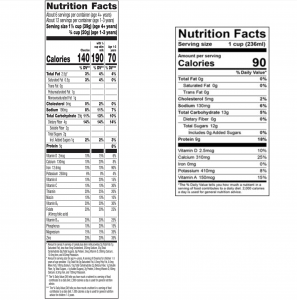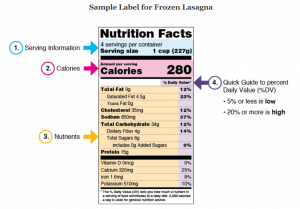Nutrition labels, nobody reads those right? Wrong! In 2016, the U.S. Food and Drug Administration (FDA) changed the nutrition label formatting to make it easier to understand. This, of course, prompted groups to study how many people actually read the label. In 2016 the Hartman Group found that of people who were watching their weight, 81 percent usually read the label, and of those who were not watching their weight, 72 percent usually read labels. Overall 42 percent of people said that they always read the nutrition label of new products.
What sparked my interest in nutrition labels? I was told to compare the nutrition label of my cereal to my milk.
Go ahead and Google “Cheerios nutrition label.” You’ll see that the left side of the label details the nutrition facts of the cereal, and the right side details the nutrition facts of the cereal with a serving of fat-free milk. Look at all the nutrients!
Now take a gallon of milk out of your fridge and look at the nutrition label, where did all the nutrients go? Of the 13 essential nutrients that milk has, Cheerios lists 10, and milk lists only five.

After seeing this I wondered why cereal has a better nutrition label than milk. And why do nutrition labels look the way they do in the first place?
To start off my journey I paid closer attention to nutrition labels. It did not take long for me to realize that all nutrition labels look about the same from the “Nutrition Facts” heading down to the percent daily value of potassium — after potassium is where things start getting funky.

Some labels, like those on cereal, run far past potassium while others stopped providing information there. In their blog about how to read nutrition labels, the FDA states that the nutrients on the standard, required label are the key nutrients that impact our health the most, so those are the ones that have to be on every nutrition label.
Makes sense, but why stop there? Milk has so many essential nutrients we could be highlighting!
As it turns out, the FDA gets lots of questions about nutrition labels, so they wrote up an article with their most popular questions — 132 pages worth! Question N4 in this article asks about restrictions against certain nutrients, and the answer is that “only those nutrients listed in FDA’s nutrition regulations, as mandatory or voluntary components of the nutrition label, may be included in the Nutrition Facts label.”
The FDA basically splits nutritional components into three categories: mandatory, voluntary, and nutrients we don’t talk about. Mandatory nutrients are those that the FDA feels affects our health the most, while voluntary ones are certainly impactful to our health, but aren’t commonly under-consumed or over-consumed in the United States. The nutrients that we don’t talk about are those that we don’t consume much of and we really don’t need.
All mandatory and voluntary nutrients have a reference daily intake (RDI) set by the Food and Nutrition Board of the National Academies of Sciences Engineering, and Medicine.
RDI’s have been calculated for different groups of people based on sex and age since the 1940s — they determine the percent daily value as seen on labels and are updated every five years. That’s why just a few years ago we were saying that milk has nine essential nutrients, rather than the current 13.
No, the nutritional value of milk has not changed, just the recommended amounts of nutrients that we need to consume.
So now we come back to the nutrition label on milk. How come we aren’t highlighting all the good things that milk has to offer? The answer isn’t clear, and the major dairy organization I reached out to wouldn’t return a call to discuss the topic. But it’s undeniable that milk could have a better label on it if we wanted it to, and some cereal companies are doing a great job at highlighting many of the important nutrients that cereal (with milk) has to offer.
If you sell products from your farm and want to add in voluntary nutrients on the label, that’s totally fine by the FDA, and you can find them on the National Institutes of Health’s website. Another great resource on creating FDA compliant labels can be found on the ESHA Research’s website.
When plant based products like Silk’s soy milk alternative and Oatly’s oat milk alternative have a more attractive nutrition label than good old dairy milk, it’s easy to see why some consumers choose the plant-based versions. There is certainly room for us to get ahead of the curve and put more nutrients on the label that real, wholesome products like real milk and meat have to offer.
Nutrition labels can be a fantastic marketing tool if we allow them to be!
Elizabeth Maslyn is a born-and-raised dairy farmer from Upstate New York. Her passion for agriculture has driven her to share the stories of farmers with all consumers, and promote agriculture in everything she does. She works hard to increase food literacy in her community, and wants to share the stories of her local farmers.



